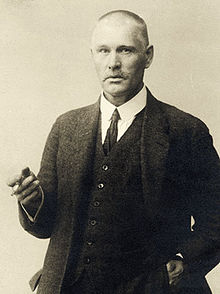Pekka halons
Pekka Halonen (born September 23, 1865 in Lapinlahti , † December 1, 1933 in Tuusula ) was a Finnish painter. He is one of the representatives of the so-called "golden age" of Finnish art at the turn of the century. Pekka Halonen is particularly known for his mostly winter landscape paintings . He is the best known offspring of the Halonen family of artists.
Life
Pekka Halonen was born on September 23, 1865 in Lapinlahti near Kuopio in the eastern Finnish Savo region as the son of the farmer Olli Halonen and his wife Vilhelmiina. The family lived in simple circumstances and had five sons and two daughters, Pekka Halonen was the third oldest of the children.
Pekka Halonen was the first of his family to choose art as his profession and studied at the drawing school of the Finnish Art Association in Helsinki from 1886–1890 . He then went to Paris from 1886 to 1894 , where he a. A. studied with Paul Gauguin and at the Académie Vitti . In 1895 Halonen married Maija Mäkinen, and the marriage resulted in eight children. In 1898 Halonen moved with his family to Tuusula in southern Finland. In the rural community north of Helsinki and neighboring Järvenpää , an artist colony had formed around the painter Eero Järnefelt , the composer Jean Sibelius and the writer Juhani Aho , a friend of Halonen. Halonen had a studio apartment Halosenniemi built there on Lake Tuusulanjärvi .
On December 1, 1933, Pekka Halonen died in his Halosenniemi house in Tuusula.
Halosenniemi Museum
Pekka Halonen's villa in Tuusula is open as a museum. The large garden, the sauna, his youngest daughter Kaija's summer hut and the beach are part of the museum grounds. The garden made the family with eight children self-sufficient. Pekka Halonen's works also deal to a large extent with fruits, plants and vegetables from his garden. B. the picture "tomatoes". The building, which was sold to the community in 1949, five years after the death of his wife Majya, is in its original state. The spirit of the artists' colony around Pekka Halonen can be guessed at on two floors and in the large studio space. Exhibits by contemporary artists are added to the exhibition of the works of Hallonen and his painter friends. Concerts and readings are also held in the house. The rocks on the beach are also suitable for a little rest or a picnic. There is information material in the museum in German.
On the other side of the main street, not far from his villa, is the Pekka Halonen Art Academy.
Works (selection)
- Niittomiehet (The Mowers, 1891)
- Pihlaja (rowan tree, 1894)
- Kaksoismuotokuva (double portrait, 1895)
- Talvipäivä (winter day, 1895)
- Vainolaisia vastaan (Against the Persecutors, 1896)
- Erämaa (wilderness, 1899)
- Ateria (meal, 1899)
- Talvinen iltarusko (Winter sunset, 1899)
- Altarpiece of the Church of Mikkeli (1899)
- Avannolla (Am Eisloch, 1900)
- Tienraivaajia Karjalassa (road builder in Karelia, 1900)
- Altarpiece of the Church of Joroinen (1901)
- Frescoes of the vestibule of the Juselium mausoleum in Pori (1902–1903)
- Altarpiece of Viipuri Cathedral (1914)
literature
- Ilka Karttunen, Anna-Maria von Bonsdorf: Pekka Halonen - Neljä vuodenaikaa / Four Seasons , Taidekeskus Retretti / Retretti Art Center, Punkaharju, Suomi / Finland 2005
Web links
- Finnish Ministry of Education website on Pekka Halonen (Finnish)
- Page of the Halosenniemi Museum on Pekka Halonen (Finnish)
| personal data | |
|---|---|
| SURNAME | Halons, Pekka |
| BRIEF DESCRIPTION | Finnish painter |
| DATE OF BIRTH | September 23, 1865 |
| PLACE OF BIRTH | Lapinlahti |
| DATE OF DEATH | December 1, 1933 |
| Place of death | Tuusula |


